
The ‘Kosher’ Nostra: Jewish Gangsters of the Lower East Side Walking Tour
Arnold Rothstein, Meir Lansky, and Benjamin "Bugsy" Siegel were just a few of the notorious Jewish mobsters who got their start in gangs and gambling on the Lower East Side before extending their bootlegging and other criminal activities to Atlantic City, Miami, Cuba, and Las Vegas. Explore questions of morality, power, & assimilation while touring the old haunts of Murder Inc., the Mafia, and the G-Men on their trail.
Your guide, Urban Historian and educator Bradley Shaw, was born on the Lower East Side, has a BA in History and Education from Brooklyn College and is a licensed NYC tour guide. He shares with us his love of the neighborhood and passion for its history. He has been a docent, walking tour guide and manager at the Museum at Eldridge Street for more than six years, in addition to doing walking tours for the LESJC, Context Travel and his own company NY History Tours.

Jewish South Florida History & Guide Online
Join us for a virtual exploration of South Florida’s Jewish history from the improbable development of Miami Beach and Miami (it’s boom, bust, and rebirth) to the first pioneers of Fort Lauderdale, as well as Broward and Palm Beach counties. Through photographs, insights from oral histories, and humorous stories, you will get a sense of synagogues, events, and eateries like Joe's Stone Crab, Wolfie's delicatessens, and many more.
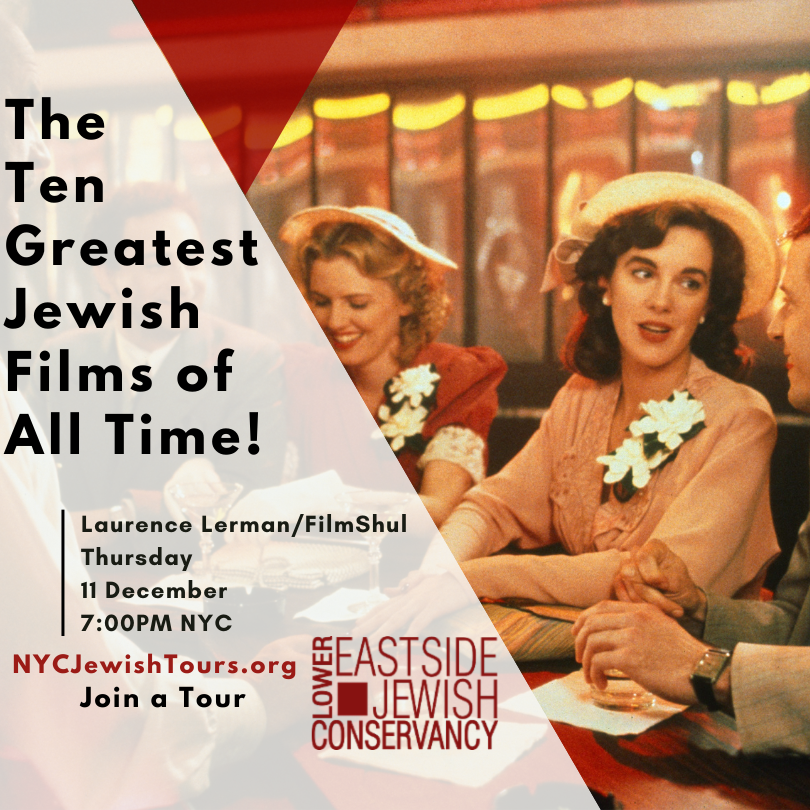
The Ten Greatest Jewish Films of All Time! on Zoom
Culled from a proud list of hundreds of movies, FilmShul goes on record to offer a catalog of the finest titles in the history of Jewish cinema. It’s a wholly opinionated breakdown, of course, and while we'll grant you that Steven Spielberg’s Schindler’s List, along with the Mel Brooks classic The Producers, are obvious "gimmes," a few of the entries are bound to surprise you! Guaranteed to provoke a lot of deep thinking, heightened conversation, and maybe even an argument or two, the Conservancy invites you to challenge FilmShul's best of the best!

“Second Hand Rose” – A Walk Down the Yiddish Rialto
Stroll down Second Avenue and discover legends and landmarks of the “Yiddish Rialto” – once home to such notable performers as Fannie Brice, Molly Picon, Boris Thomashefsky, Paul Muni, and the woman who transformed American popular theatre, Sophie Tucker.
For a bit of nostalgia, maybe even stop for a chocolate egg creme!
Your guide for this trip down memory lane is urban historian and educator Brad Shaw, who was born on the Lower East Side, has a BA in History and Education from Brooklyn College, and is a licensed NYC tour guide. He shares with us his love of the neighborhood and passion for its history. Brad has been a docent, walking tour guide, and manager at the Museum at Eldridge Street.

The Jewish Harlem Walking Tour
Once the second largest Jewish community in the United States, Harlem was home to more than 175,000 Jews. This tour visits the exteriors of grand synagogues, including the Ethiopian Hebrew Synagogue. Conservancy guide Barry Judelman leads tour-goers through the sites of Jewish religious life in the remarkable urban settlement of Harlem, once the second largest Jewish community in the United States. In 1917, Harlem was home to more than 175,000 Jews. This tour visits the exteriors of grand synagogues, including the Ethiopian Hebrew Synagogue "The Commandment Keepers," Temple Israel of Harlem, Congregation Shaarei Zedek and The Oheb Zedek Synagogue (former home to Cantor Yossele Rosenblatt).
Your guide for this tour will be Barry Judelman, a passionate city resident since the early ’80s. Barry transforms his love for area preservation and storytelling into fascinating tours celebrating the vibrant Jewish presence throughout the city. His tours offer an insider’s view of New York City’s best-kept secrets, taking you through neighborhoods rich with history and stories waiting to be uncovered. Whether you’re a local or a visitor, his expertly guided tours promise an unforgettable exploration of the city’s Jewish legacy, blending historical insights with contemporary observations.
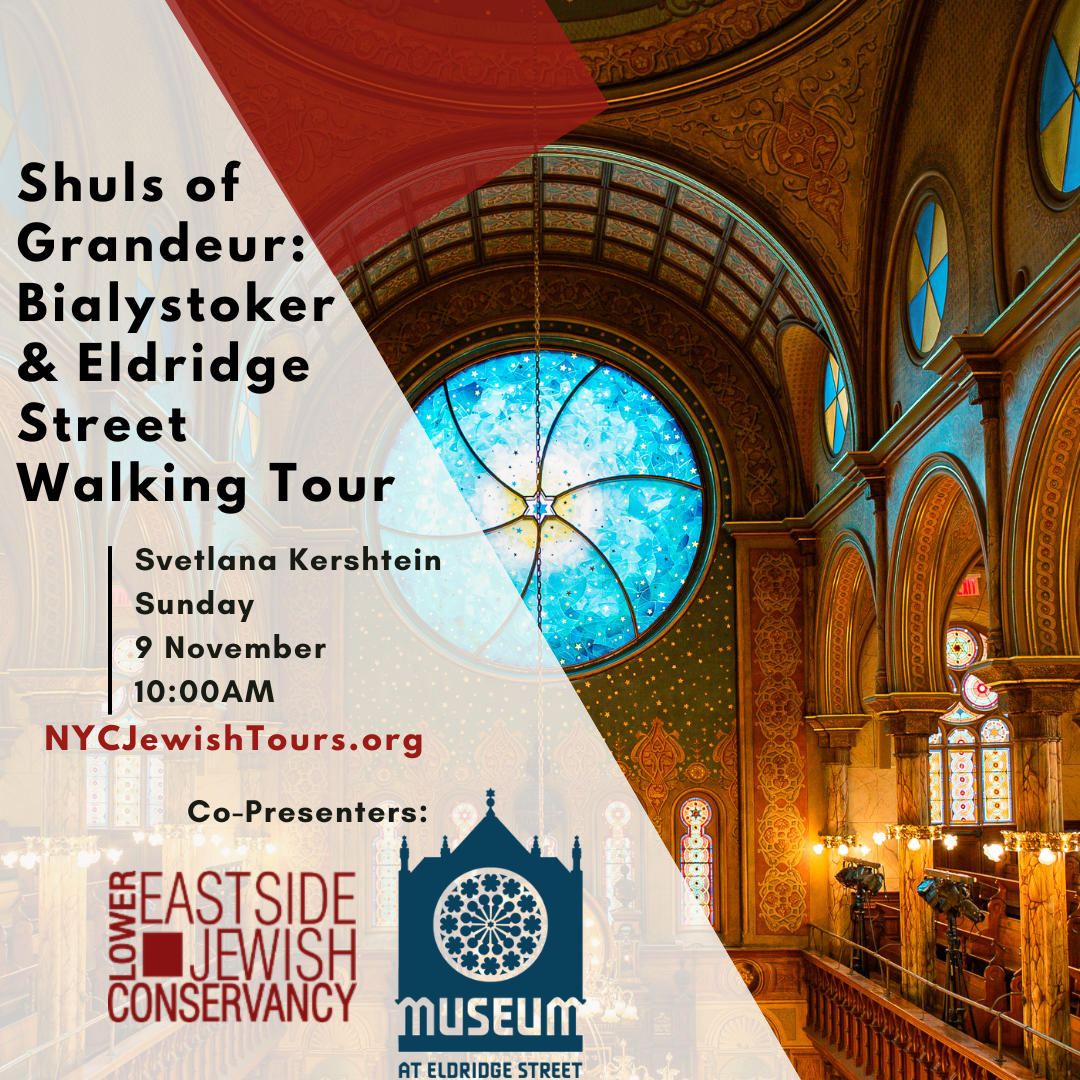
Shuls of Grandeur: Bialystoker & Eldridge Street Walking Tour
Join the Lower East Side Jewish Conservancy and the Museum at Eldridge Street for a joint tour, Shuls of Grandeur, featuring two historic, grand synagogues. The Bialystoker Synagogue, a former church and stop on the Underground Railroad, is the largest active congregation on the Lower East Side today. Known for its murals, Tiffany-inspired glass windows, as well as famous and infamous past congregants, including Jewish gangsters. From there we will walk down historic East Broadway discussing the Educational Alliance, the Henry Street Settlement, Seward Park (the first municipally-built free playground in the United States), Straus Square, and much more. We will end with a visit to the Museum at Eldridge Street, located in the first great house of worship purpose-built in the United States by Eastern European Jewish immigrants in 1887.

Colonial Jewish New Amsterdam Walking Tour
New York City has long been home to the largest Jewish community in the United States, but did you know it was the first? This tour traces the remarkable journey of the very first American Jewish community: a small group of Jewish refugees from Brazil who arrived in New Amsterdam in 1654, established the first synagogue, and fought for the rights and freedoms of future generations.
We’ll begin at the mouth of New York Harbor, where we’ll explore the broader story of Jewish life in the Caribbean before following the refugees’ path to New Amsterdam. At the monument honoring these first arrivals, we’ll uncover the struggles they endured to remain in the Dutch colony. From there, we’ll walk the old streets of New Amsterdam, tracing the lives of these early pioneers and their impact on the city’s and country’s development. Along the way, we’ll stop at the site of New York’s first synagogue, Shearith Israel, and learn about its enduring legacy. Our journey concludes at the oldest Jewish cemetery in the United States—now tucked within the bustling heart of Chinatown.
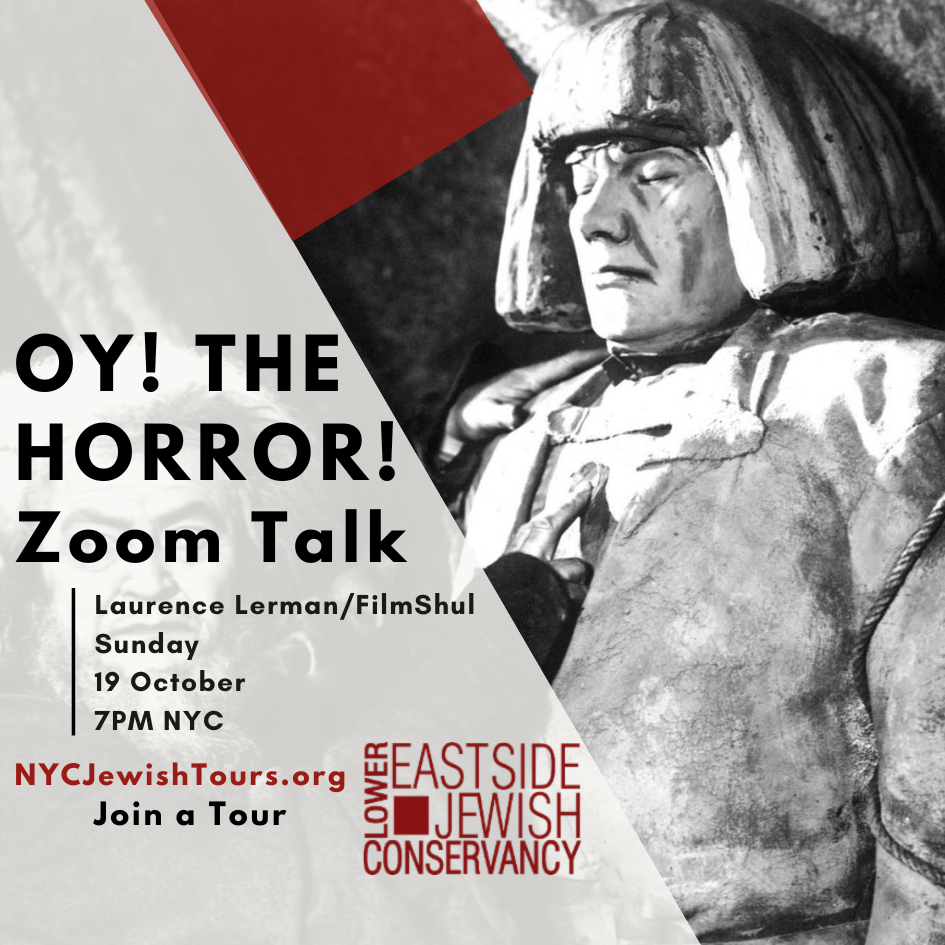
Oy! The Horror! Zoom Talk
Beginning with the landmark 1920 German silent film The Golem, based on the ancient Hebrew legend, Jewish horror films have proven to be one of cinema’s most fascinating sub-genres. From the shocks of such chillers as The Unborn, The Possession, and The Vigil to the horrific yucks of The Fearless Vampire Killers and An American Werewolf in London, no tombstone will be left unturned! We’ll also run down the stories behind a couple of the major “Christian” horror films that were made by Jewish filmmakers (The Exorcist, anyone?). Join the Conservancy for a FilmShul program that takes an occasionally terrifying but often light-hearted look at the history, growth, and status of Jewish horror cinema.
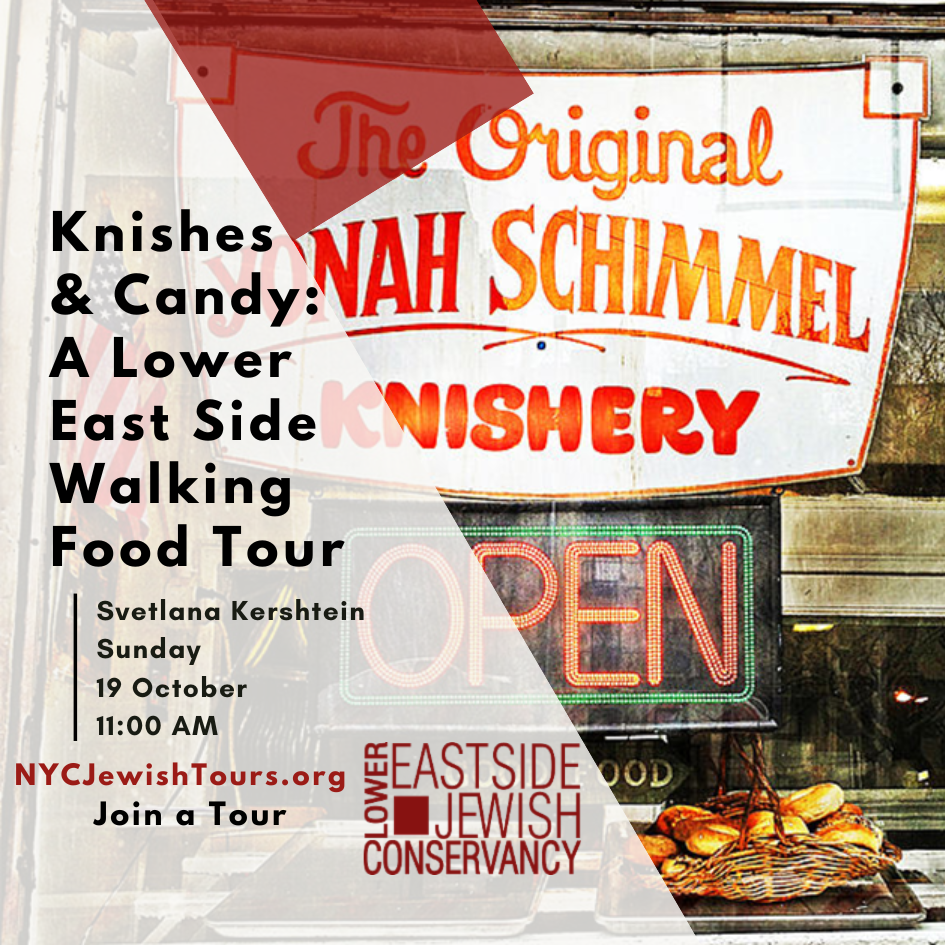
Knishes and Candy: A Lower East Side Walking Food Tour
From flaky, golden old-world classic knishes to chewy old-school candies, this tasty walking tour will introduce you to the delicious traditions of New York City’s most iconic immigrant neighborhood. As you wander the bustling streets of the Lower East Side, you’ll pop into legendary bakeries, candy shops, and hidden gems, sampling treats that have delighted locals for generations and discover modern twists that keep the neighborhood a vibrant foodie paradise today. Come hungry, leave happy (and maybe a little nostalgic).
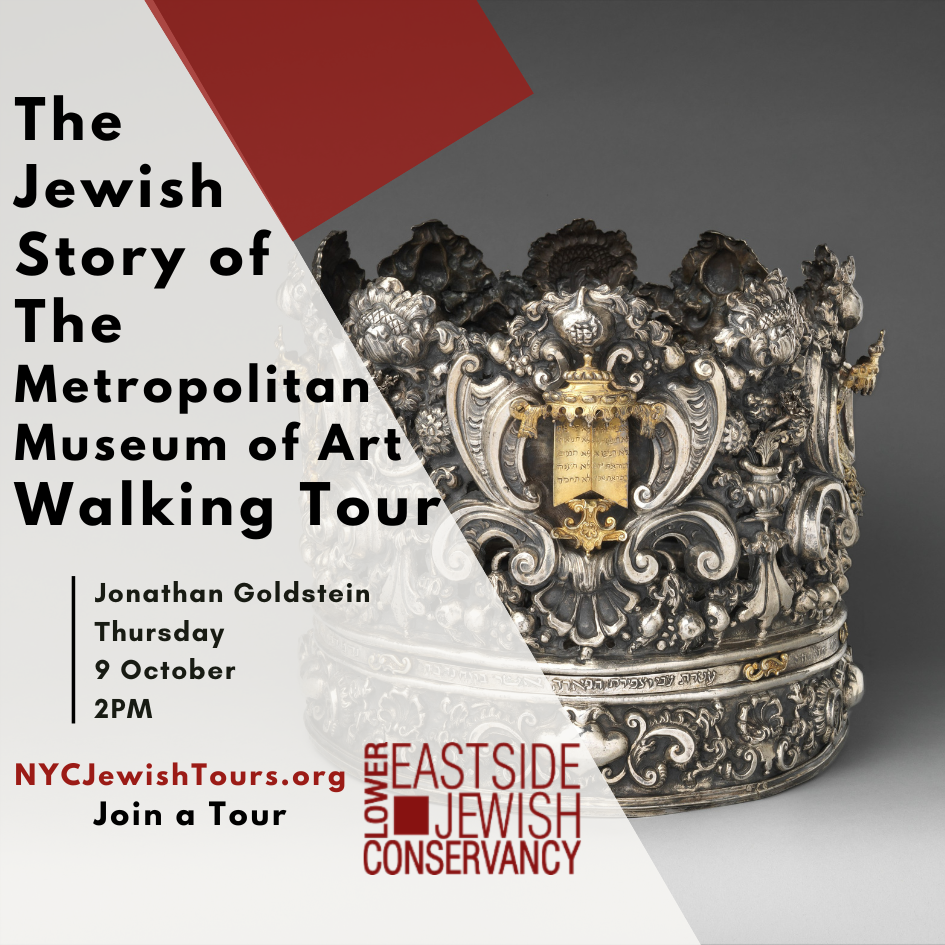
The Jewish Story of The Metropolitan Museum of Art Walking Tour
The Metropolitan Museum of Art is one of the greatest museums in the world, and this tour reveals its treasures through a distinctly Jewish lens. Together, we’ll trace the Jewish story across time and place—encountering biblical artifacts, rare Hebrew manuscripts, exquisite pieces of Judaica, and works by Jewish artists whose legacies shaped art history. Along the way through galleries spanning ancient Egypt and Rome, the grandeur of America’s Gilded Age, the spirituality of Europe’s Middle Ages, and the creativity of 20th-century Paris, we’ll also uncover the role of Jewish patrons and the MET’s own Jewish history. Join us Chol HaMoed to reflect on the breadth and depth of the Jewish diaspora across centuries and continents.

Jewish Brighton Beach Walking Tour: From Luxury Resort to Little Odessa
Brighton Beach was always famous as a simple residential neighborhood attracting people with its wide sandy beaches, ocean breeze and tons of attractions on neighboring Coney Island. But did you know that it started as an upper middle class resort with several luxury hotels, largest bathing Pavilion, race track and famous outdoor concert venues. In early 1920s resorts were replaced with the residential neighborhoods and a lot of Jewish immigrants, mostly young families, moved here escaping overcrowded LES and some other areas of the city. They built a number of synagogues and opened many Jewish business. After short period of prosperity the Great Depression hit, and Brighton Beach changed significantly filled with tens of thousands of jobless homeless Jewish families who overcrowded once luxurious spacious apartments. In the following years there were additional waves of Jewish immigrants from Europe escaping the Nazis, Holocaust survivors after the WWII. The influx of Soviet Jewish refugees in 1970s changed the face of Brighton Beach completely, filled it with young people, exotic food and culture, made it “Little Odessa (Ukraine) by the Sea.” In our tour we’ll visit some of the still functioning old synagogues, see the once luxury Art Deco houses where Jewish immigrants of 1920s lived, walk the famous Brighton Beach Ave while talking about Russian-speaking Jewish emigration, and see the spot where the original Brighton Beach resort hotels once stood.
Your guide for this tour is Svetlana Kershtein, a professional tour guide who has worked on three continents and holds a Masters Degree in History, specializing in the history of the ancient world. Born in the Soviet Union, she emigrated to Israel where she worked as a licensed tour guide for 11 years. Svetlana’s passion for Jewish history, art, music, and cuisine is reflected in her popular tours for the Conservancy. She is fluent in three languages (English, Hebrew, and Russian).
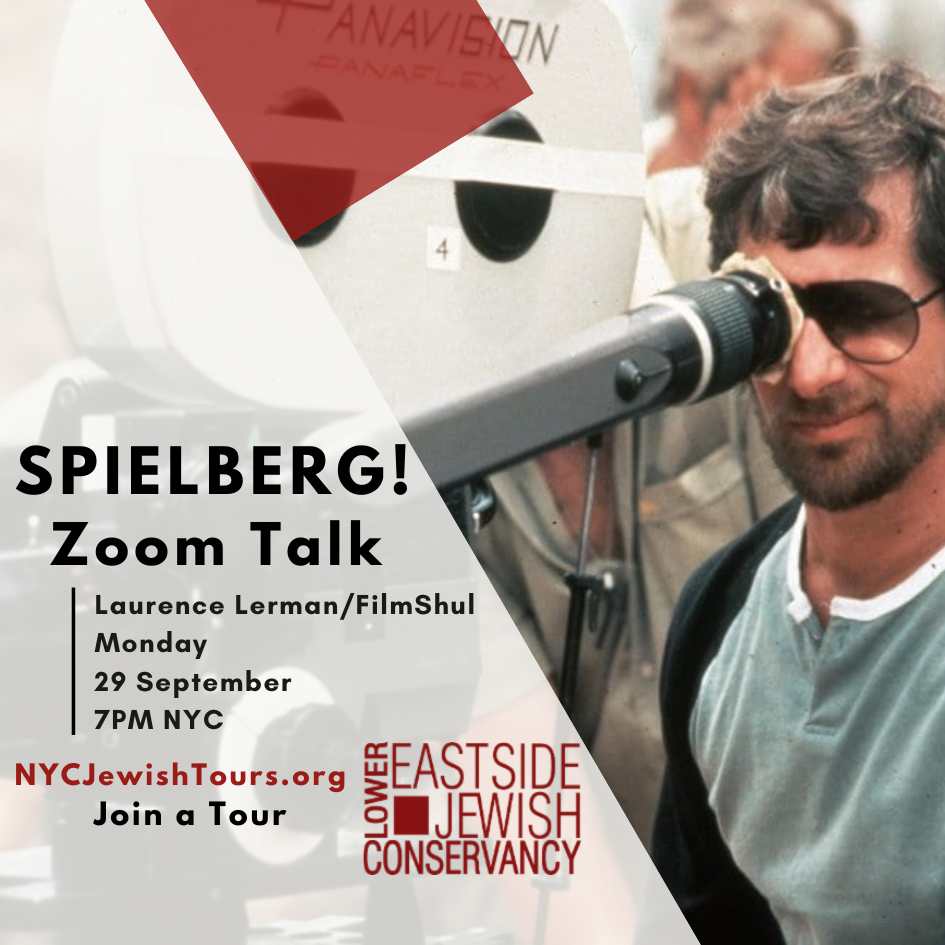
Spielberg! Zoom Talk
Like the “Fellini-esque” Fellini and the “Hitchcockian” Hitchcock before him, Steven Spielberg is an artist whose work is so ubiquitous and instantly identifiable that his name has inspired its very own adjective: “Spielbergian.” One of the most commercially successful directors of all time, Spielberg is the creator of such beloved modern classics as Jaws, Close Encounters of the Third Kind, E.T., and the Indiana Jones and Jurassic Park series. In this FilmShul production, we examine the life and career of the grand storyteller, with a particular focus on his upbringing as an Orthodox Jew and his later Jewish re-awakening, which yielded such vital works as Schindler’s List and Munich. His interests have also inspired the creation of the Shoah and Righteous Persons Foundations.
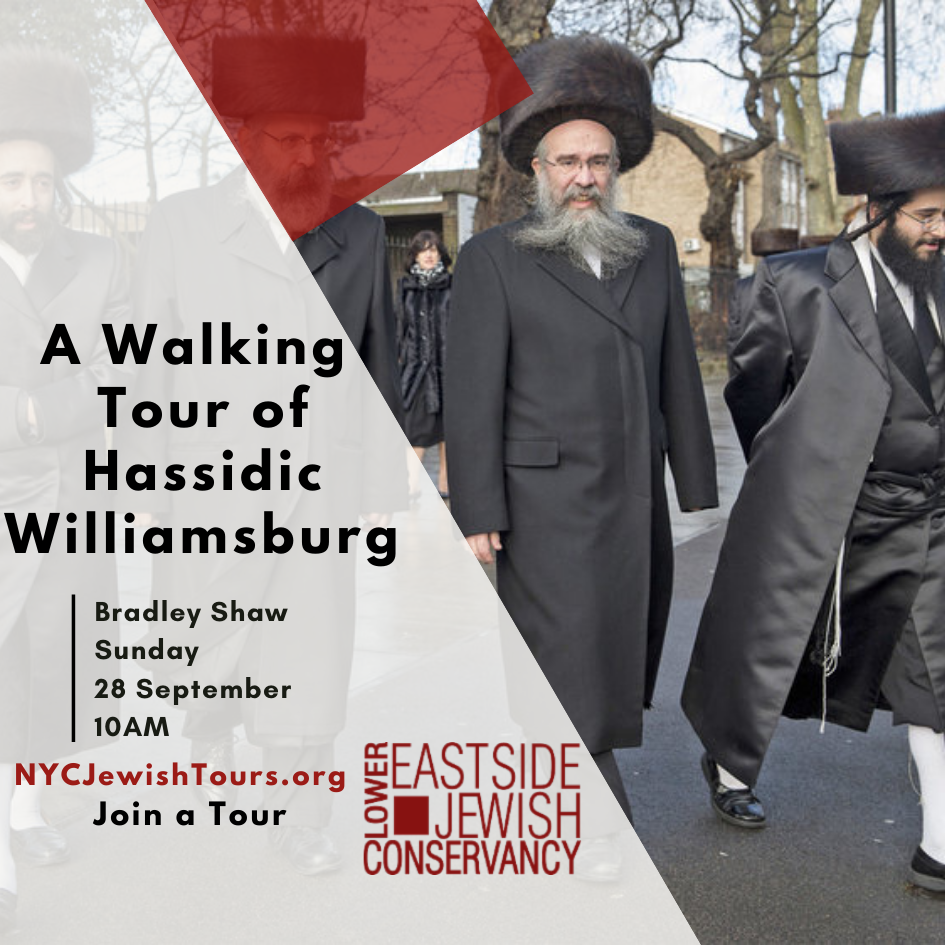
A Walking Tour of Hassidic Williamsburg
Step into streets where centuries-old shtetl traditions meet the bustle of modern life in Brooklyn. See modest row houses, Yiddish storefronts and newspapers, as well as scores of strimels (distinctive fur hats), sheitels (wigs), and shtiblekh (prayer rooms) in one of the world’s largest Hassidic communities. Join educator and urban historian Bradley Shaw for an immersive experience in this fascinating neighborhood, including significant synagogues like Beth Jacob Ohev Sholom, the oldest Orthodox Jewish congregation in Brooklyn, and Beth Elohim, an 1875 Gothic Synagogue built by Reform Jews and now housing a Hasidic yeshiva. You will also visit Lee Avenue, the main shopping area, Bais Rachel, a NYC High School turned girl’s yeshiva, and hear other stories of the fabric of Hasidic Williamsburg, with a little bit of Hipster Williamsburg mixed in.
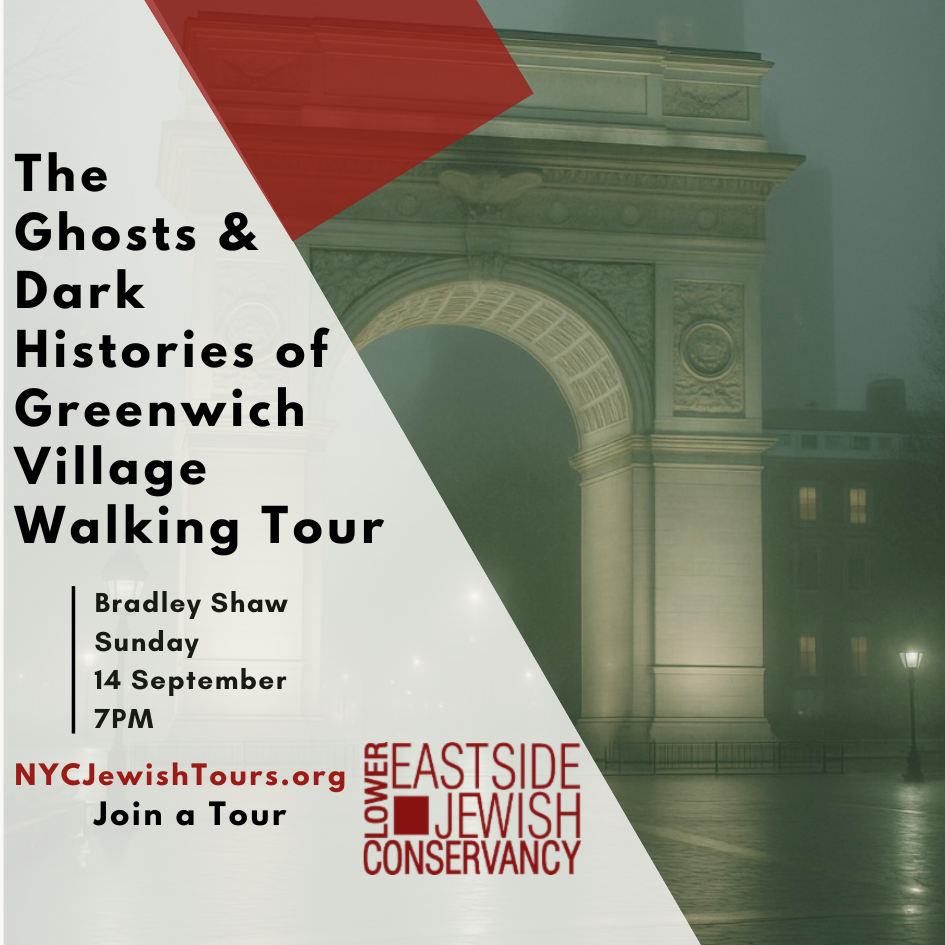
The Ghosts & Dark Histories of Greenwich Village Walking Tour
As one of the oldest parts of the city, the Greenwich Village area is scarred by places where ghosts haunt and illicit activities became legendary. By flickering lamplight, discover the benevolent spirit of a heartbroken playwright, the site of an almost unspeakable tragedy, and the buildings that were formerly bordellos and political cafes. Along the way, you’ll hear about a “hidden” cemetery, ghosts from the past and present, and other stories from the shadows—all with a special Jewish connection. Join Brad for a spine-tingling walk from the East Village to the West, where the past refuses to rest.
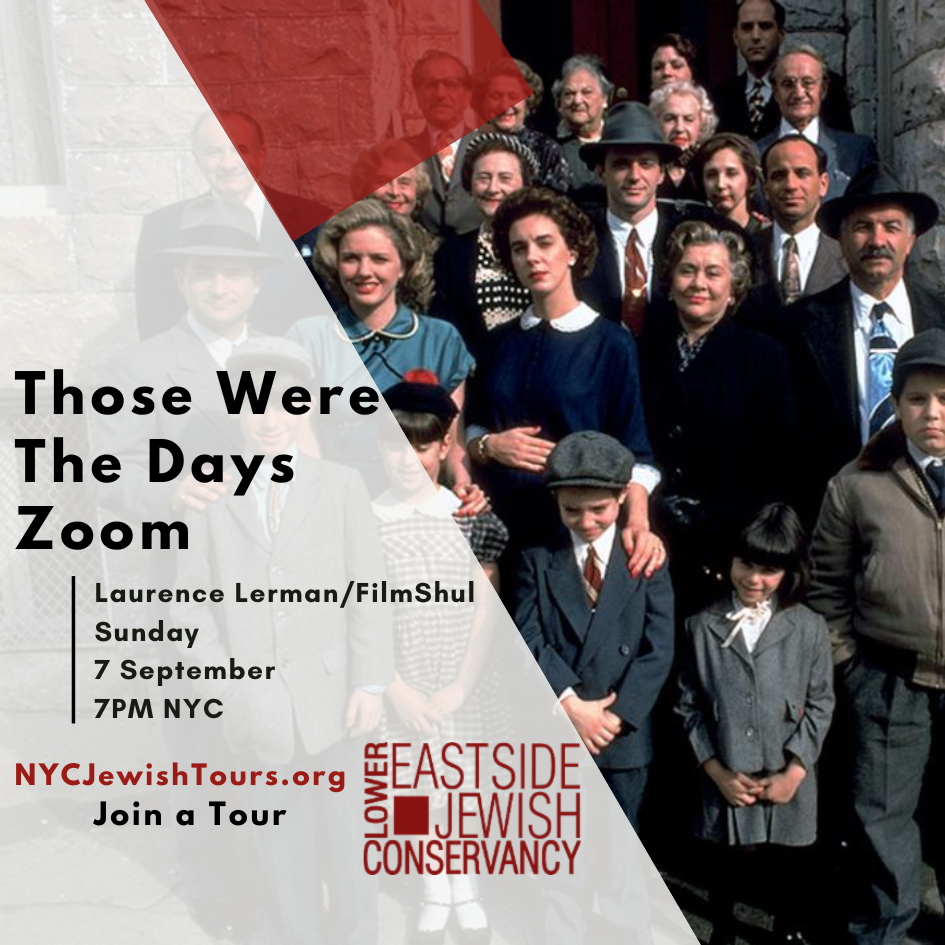
Those Were The Days Zoom
From Barry Levinson’s Diner, Tin Men, and Avalon, to Woody Allen’s Radio Days and Bullets Over Broadway, and on to beloved classics like My Favorite Year, The Chosen, Brighton Beach Memoirs, and even the animated gem An American Tail, this FilmShul production celebrates a rich collection of nostalgic Jewish films that lovingly revisit the “good old days.” These cinematic stories are deeply rooted in the timeless tradition of Jewish storytellers—Sholom Aleichem, Chaim Potok, Philip Roth, Michael Chabon, Cathleen Schine, and others—who weave memory, humor, and heart into their work. Extending beyond film, we’ll also explore sentimental television favorites known for their warmth and wit, such as Brooklyn Bridge, The Goldbergs, and The Marvelous Mrs. Maisel.

Synagogues of the Lower East Side Walking Tour
One hundred years ago, when over a million impoverished Jewish immigrants crowded the streets and tenements of the Lower East Side, it seemed like every street had at least one synagogue. Journey with urban historian and LES native Bradley Shaw to the heart of the neighborhood, where you will see the Bialystoker Synagogue and hear stories of shuls and stieblachs.

Son of Super Funny Jewish Men Zoom
Who knew there were so many funny, funny Jewish men? Join us for a time-spanning examination of those cunning comics and lovable losers who will go to any length to satisfy us with a smile. This time ‘round, we look at the lives and careers of such funny men as Albert Brooks, The Three Stooges, Sacha Baron Cohen, Jerry Lewis, Eugene Levy, Woody Allen, and TV legend Norman Lear, among others. Be there or be square. Join the Conservancy for a FilmShul production!
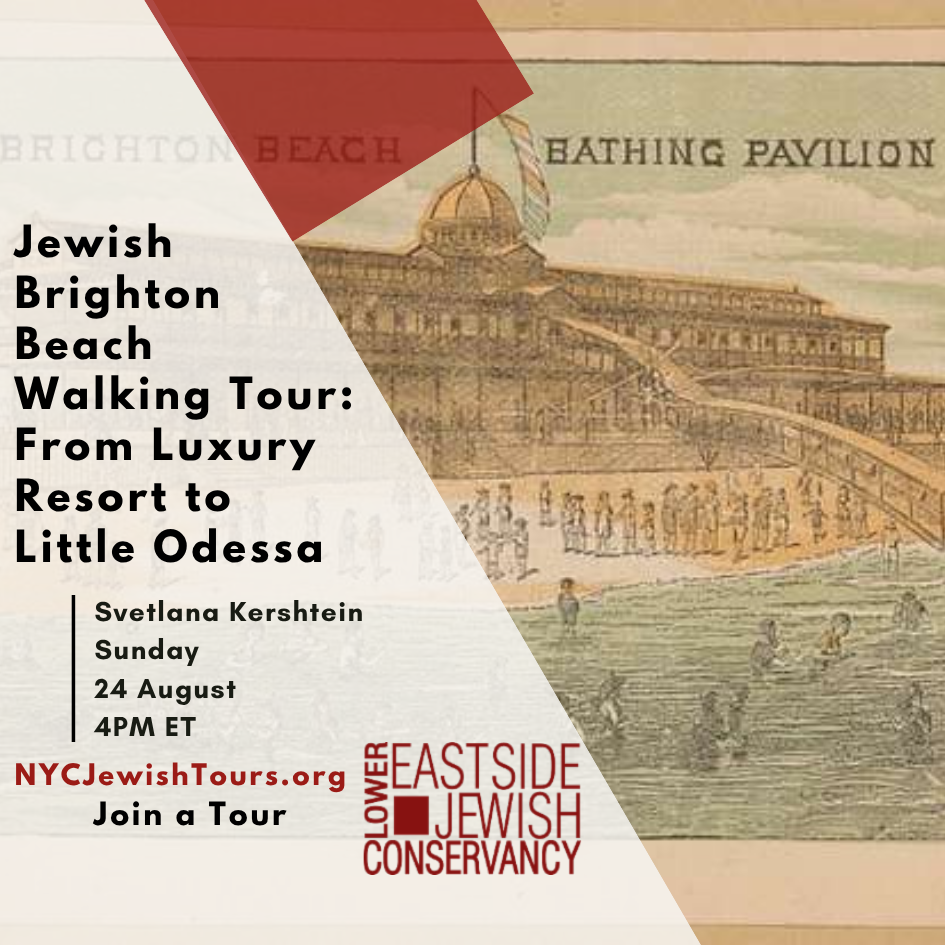
Jewish Brighton Beach Walking Tour: From Luxury Resort to Little Odessa
Brighton Beach was always famous as a simple residential neighborhood attracting people with its wide sandy beaches, ocean breeze and tons of attractions on neighboring Coney Island. But did you know that it started as an upper middle class resort with several luxury hotels, largest bathing Pavilion, race track and famous outdoor concert venues. In early 1920s resorts were replaced with the residential neighborhoods and a lot of Jewish immigrants, mostly young families, moved here escaping overcrowded LES and some other areas of the city. They built a number of synagogues and opened many Jewish business. After short period of prosperity the Great Depression hit, and Brighton Beach changed significantly filled with tens of thousands of jobless homeless Jewish families who overcrowded once luxurious spacious apartments. In the following years there were additional waves of Jewish immigrants from Europe escaping the Nazis, Holocaust survivors after the WWII. The influx of Soviet Jewish refugees in 1970s changed the face of Brighton Beach completely, filled it with young people, exotic food and culture, made it “Little Odessa (Ukraine) by the Sea.” In our tour we’ll visit some of the still functioning old synagogues, see the once luxury Art Deco houses where Jewish immigrants of 1920s lived, walk the famous Brighton Beach Ave while talking about Russian-speaking Jewish emigration, and see the spot where the original Brighton Beach resort hotels once stood.
Your guide for this tour is Svetlana Kershtein, a professional tour guide who has worked on three continents and holds a Masters Degree in History, specializing in the history of the ancient world. Born in the Soviet Union, she emigrated to Israel where she worked as a licensed tour guide for 11 years. Svetlana’s passion for Jewish history, art, music, and cuisine is reflected in her popular tours for the Conservancy. She is fluent in three languages (English, Hebrew, and Russian).
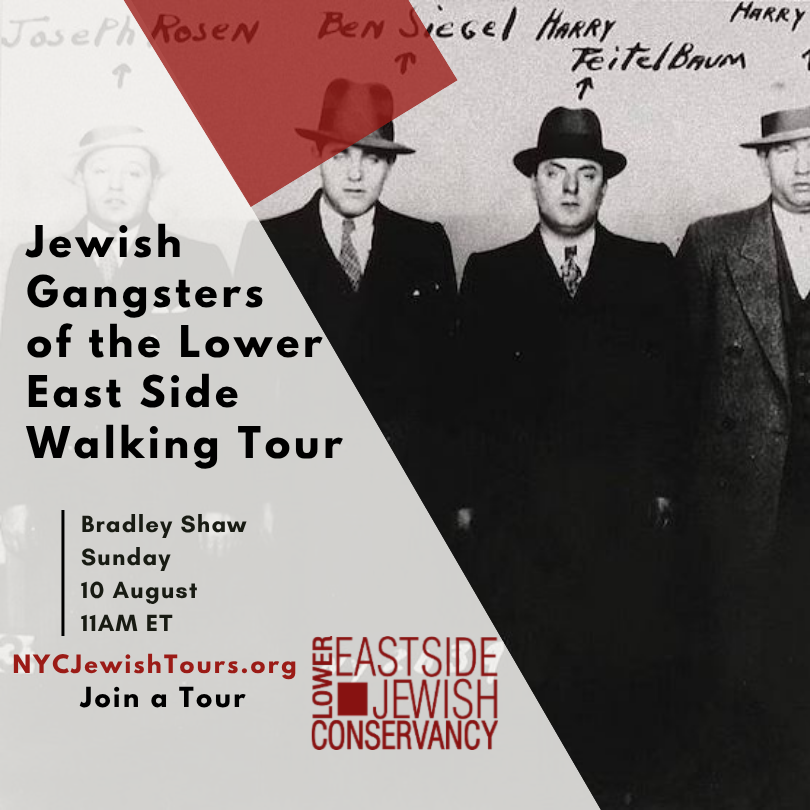
Jewish Gangsters of the Lower East Side Walking Tour
Arnold Rothstein, Meir Lansky, and Benjamin "Bugsy" Siegel were just a few of the notorious Jewish mobsters who got their start in gangs and gambling on the Lower East Side before extending their bootlegging and other criminal activities to Atlantic City, Miami, Cuba, and Las Vegas. Explore questions of morality, power, & assimilation while touring the old haunts of Murder Inc., the Mafia, and the G-Men on their trail.
Your guide, Urban Historian and educator Bradley Shaw, was born on the Lower East Side, has a BA in History and Education from Brooklyn College and is a licensed NYC tour guide. He shares with us his love of the neighborhood and passion for its history. He has been a docent, walking tour guide and manager at the Museum at Eldridge Street for more than six years, in addition to doing walking tours for the LESJC, Context Travel and his own company NY History Tours.

Virtual Tour of Savannah’s Historic Mickve Israel Synagogue
Shalom y'all! Join us for an exclusive virtual tour of America's third oldest Jewish Congregation and the only neo-Gothic synagogue in the United States. In 1733, a group of mostly Spanish & Portuguese Sephardic Jewish immigrants arrived in Georgia from England, where they had found refuge from the horrors of the Inquisition. Bringing with them a Torah scroll from London's Bevis Marks, the group settled in Savannah and founded Mickve Israel, the state's first synagogue, in July 1735. Construction of the sanctuary began in 1876 and was completed in 1878. New York architect Henry G. Harrison pure neo-Gothic design reflected the fashionable architecture of the Victorian era. Congregation Mickve Israel was named one of the “15 Most Beautiful Synagogues in the World” by Condé Nast Traveler and rated among the “15 BEST Things to Do in Savannah” by Trip Advisor.
Your guide for this tour will be Rabbi Robert Haas, a native of McAllen, Texas, who became the 14th spiritual leader of Congregation Mickve Israel in Savannah, Georgia, in 2012. After receiving his B.S. from the University of Texas at Austin, he began his first career as an elementary school teacher before matriculating at Hebrew Union College in Jerusalem and Los Angeles, where he earned his Master’s Degree and Rabbinical Ordination. After graduation, he served as an associate rabbi in Dallas and in Houston, Texas. He then spent a year volunteering in Africa with American Jewish World Service before moving to Savannah. Rabbi Haas is a sought-after comedian, lecturer, preacher, and interfaith leader, regularly speaking and performing for organizations, radio shows, colleges, theaters, houses of worship, and institutions.

A Catskill Carnival Virtual Tour: My Borscht Belt Life Lived, Lost, and Loved
Join a 3rd generation insider with no illusions for a behind-the-scenes look at the Borscht Belt’s Golden Era. It wasn’t all sunshine and glamor. This tour peels back the glitzy showbiz tales and shows the gritty, heartfelt reality of growing up in this once-thriving region. Learn how life was tough, turbulent, and alternately warm and hard. Hear how the Catskills flourished and faltered, how it felt to watch the life you knew and your livelihood fall apart, as well as how to pick it all up again in new ways. It’s actually a different kind of love story. How one hotel brat went from ambivalence to appreciation to passion over a lifetime. “We were carnies – carnival people – only we didn’t move the tents. That’s the Borscht Belt in a nutshell, and we were the chief nuts.”
Born into the carnival life of a Borscht Belt Catskills hotel family, your guide, Bart A. Charlow, has never let the ordinary constrain him. From professional photography to painting, he has always set his creativity free, now entering into the realm of authorship. His first book, "A Catskill Carnival", is a memoir of his early years captures the the hustle, the heart, and humor of the real Borscht Belt. "Pickle Barrel Tales", his second book is a companion to Carnival, featuring over 50 wry vignettes from several "mountain rats" about the Borscht Belt, illustrated with humorous sketches. He has been a favored speaker on TV, radio, and in print media for decades. Among honors he holds is the Jefferson Award for his community leadership and service.

A Walking Tour of Hassidic Williamsburg
Chasidic Williamsburg is a neighborhood steeped in history and tradition and is home to one of the largest concentrations of Haredi Jews in the world. As you walk through the streets, you'll notice the distinctive attire of the Chasidic men and woman as well as the businesses which complement the still growing population. Join educator and urban historian Bradley Shaw as you explore this fascinating neighborhood, including significant synagogues like Beth Jacob Ohev Sholom, the oldest Orthodox Jewish congregation in Brooklyn, and Beth Elohim, an 1875 Gothic Synagogue built by Reform Jews and now housing a Chasidic Yeshiva. You will also visit Lee Avenue, the main shopping area, Bais Rachel, a NYC High School turned girl’s Yeshiva and hear other stories of the fabric of Chasidic Williamsburg, with a little bit of Hipster Williamsburg mixed in.
Your guide, Urban Historian and educator Bradley Shaw, was born on the Lower East Side, has a BA in History and Education from Brooklyn College and is a licensed NYC tour guide. He shares with us his love of the neighborhood and passion for its history. He has been a docent, walking tour guide and manager at the Museum at Eldridge Street for more than six years, in addition to doing walking tours for the LESJC, Context Travel and his own company NY History Tours.

LES Jewish Socialists, Communists, and Anarchists: A Walking Tour
From 1880 to 1924, almost 3 million Jews left the Pale of Settlement in Eastern Europe for a better life where the streets were paved with gold, the land of opportunity; the United States. Most settled on the Lower East Side of Manhattan where the opportunity was abundant, but their salaries and living conditions were subpar at best. The great majority were not happy, but too overwhelmed by their new homeland to complain. But some, like Lower East Side residents Emma Goldman, Alexander Berkman, Morris Hillquit, Abraham Cahan and Meyer London, knew there should be a better life and were willing to do just about ANYTHING to get there. This walking tour will focus on these “radicals” - anarchists, communists and socialists all - who tried to change the structure of the American Way to improve the lives of these immigrants and improve their standard of living - whether through our democratic process or through lawless acts of violence. Some of the places we will visit: The Daily Forward Building, The first home of Emma Goldman in NYC, Locations of radical cafes, The location of the Yom Kippur riots of 1898, The still active DSA - Democratic Socialists of America, The Educational Alliance - whose benefactors were anything but radical, and The Henry Street Settlement.
Your guide, Urban Historian and educator Bradley Shaw, was born on the Lower East Side, has a BA in History and Education from Brooklyn College and is a licensed NYC tour guide. He shares with us his love of the neighborhood and passion for its history. He has been a docent, walking tour guide and manager at the Museum at Eldridge Street for more than six years, in addition to doing walking tours for the LESJC, Context Travel and his own company NY History Tours.

Extraordinary Women of the Lower East Side Walking Tour
When you think about the important people who helped shape the Lower East Side, do mostly men come to mind such as Forward editor Abraham Cahan, reformer Jacob Riis, AFL president Samuel Gompers, entertainers George Gershwin and Irving Berlin and even gangsters Bugsy Siegel and Meyer Lansky?
What about the women? They had just as much influence (both good and bad) as their more famous male counterparts and were just as important in shaping political attitudes, fighting for rights, and giving the neighborhood a better feeling about their place in the world.
Join historian and urban archeologist Brad Shaw for a stroll around the Lower East Side as he introduces you to some of these women, both famous and infamous, who were ingrained in the attitudes and social reforms of this immigrant neighborhood.
Some of the women you will meet:
The editor of an important Yiddish newspaper
Labor leaders who were instrumental in upgrading working conditions
Social reformers who fought for better care and living conditions
One of the most famous criminals of the 19th century
The most famous political activist of all time

Extraordinary Women of the Lower East Side
When you think about the important people who helped shape the Lower East Side, do mostly men come to mind such as Forward editor Abraham Cahan, reformer Jacob Riis, AFL president Samuel Gompers, entertainers George Gershwin and Irving Berlin and even gangsters Bugsy Siegel and Meyer Lansky?
What about the women? They had just as much influence (both good and bad) as their more famous male counterparts and were just as important in shaping political attitudes, fighting for rights, and giving the neighborhood a better feeling about their place in the world.
Join historian and urban archeologist Brad Shaw for a stroll around the Lower East Side as he introduces you to some of these women, both famous and infamous, who were ingrained in the attitudes and social reforms of this immigrant neighborhood.
Some of the women you will meet:
The editor of an important Yiddish newspaper
Labor leaders who were instrumental in upgrading working conditions
Social reformers who fought for better care and living conditions
One of the most famous criminals of the 19th century
The most famous political activist of all time

Tour of Sacred Words: Revealing The Oldest Jewish Book at The JTS
Join us for an exclusive tour of Sacred Words, an exhibit that reveals the Afghan Liturgical Quire, the oldest Jewish codex. Meet the intrepid researcher, Herschel Hepler, who spent seven years tracing the book back to its discovery in a cave near the Bamiyan Buddha statues. Herschel will be joined by Sara Aharon, author of From Kabul to Queens: The Jews of Afghanistan and Their Move to the United States.

Tour of America’s First Jewish Congregation: Shearith Israel
Take a guided tour of America’s oldest Jewish congregation, Shearith Israel: New York's Spanish & Portuguese Synagogue. Led by Sexton Zachary Edinger, this walk through history offers a rare glimpse into the remarkable legacy of America's first Jewish community.

Sephardic Jews in America: A Walking Tour & Special Visit to The CJH
In 1654, 23 Jews escaping the newly instituted Portuguese Inquisition in Brazil, landed in New Amsterdam (New York City) and were almost immediately expelled by Peter Stuyvesant. They persevered and there has been a Jewish and notably a Sephardic presence in this country for over 370 years, or 120 before the founding of the United States.
Join us on a captivating walking tour that unveils the rich and often untold history of the Sephardic Jewish community in New York City. Some of the sites visited will include colonial era cemeteries, famous homes and religious sites - all with stories of history, heritage and culture.
The walking tour concludes with a visit to the Center for Jewish History on East 16th Street, where guests will receive an exclusive, behind-the-science tour of treasures from both the American Jewish Historical Society and American Sephardi Federation, offering a fascinating glimpse into the rich cultural legacy of the Sephardic Jews in America.

A Zoom Tour of Hassidic Williamsburg
Williamsburg is a neighborhood steeped in history and tradition and is home to one of the largest concentrations of Haredi Jews in the world. As you walk through the streets, you'll notice the distinctive attire of the Hasidic men and woman as well as the businesses which complement the still growing population.
Join educator and urban historian Bradley Shaw as you virtually explore this fascinating neighborhood, including significant synagogues like Beth Jacob Ohev Sholom, the oldest Orthodox Jewish congregation in Brooklyn, and Beth Elohim, an 1875 Gothic Synagogue built by Reform Jews and now housing a Chasidic Yeshiva. You will also visit Lee Avenue, the main shopping area, Bais Rachel, a NYC High School turned girl’s Yeshiva and hear other stories of the fabric of Chasidic Williamsburg, with a little bit of Hipster Williamsburg mixed in.

A Walking Tour of Hassidic Williamsburg
Williamsburg is a neighborhood steeped in history and tradition and is home to one of the largest concentrations of Haredi Jews in the world. As you walk through the streets, you'll notice the distinctive attire of the Hasidic men and woman as well as the businesses which complement the still growing population.
Join educator and urban historian Bradley Shaw as you explore this fascinating neighborhood, including significant synagogues like Beth Jacob Ohev Sholom, the oldest Orthodox Jewish congregation in Brooklyn, and Beth Elohim, an 1875 Gothic Synagogue built by Reform Jews and now housing a Chasidic Yeshiva. You will also visit Lee Avenue, the main shopping area, Bais Rachel, a NYC High School turned girl’s Yeshiva and hear other stories of the fabric of Chasidic Williamsburg, with a little bit of Hipster Williamsburg mixed in.

Jewish Gangsters of the Lower East Side Walking Tour
Learn where leaders of the Jewish Underworld began their nefarious activities, and discuss questions of morality, power, & assimilation. Arnold Rothstein, Meir Lansky and Bugsy Siegel were all notorious gangsters whose criminal activities extended to Atlantic City, Miami, Cuba and Las Vegas, but their stories began on the Lower East Side of New York. We will examine where these leaders of the Jewish underworld began their nefarious activities. Along the way we will analyze questions of morality, power and assimilation. Use your imagination to evoke what once existed, as we view sites that were associated with these Jewish Gangsters.
Your guide, Urban Historian and educator Bradley Shaw, was born on the Lower East Side, has a BA in History and Education from Brooklyn College and is a licensed NYC tour guide. He shares with us his love of the neighborhood and passion for its history.

Jewish Harlem Walking Tour
When you speak of Harlem, the most famous African-American community in the world comes to mind. But did you know Harlem was once the third largest Jewish neighborhood in the world from 1870 -1930, after New York's Lower East Side and Warsaw, Poland?
Your guide, Urban Historian and educator Bradley Shaw, was born on the Lower East Side, has a BA in History and Education from Brooklyn College and is a licensed NYC tour guide. He shares with us his love of the neighborhood and passion for its history.
